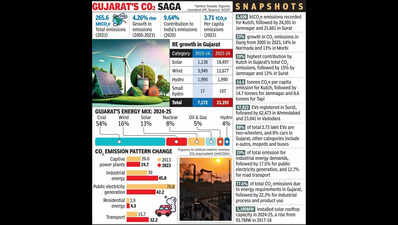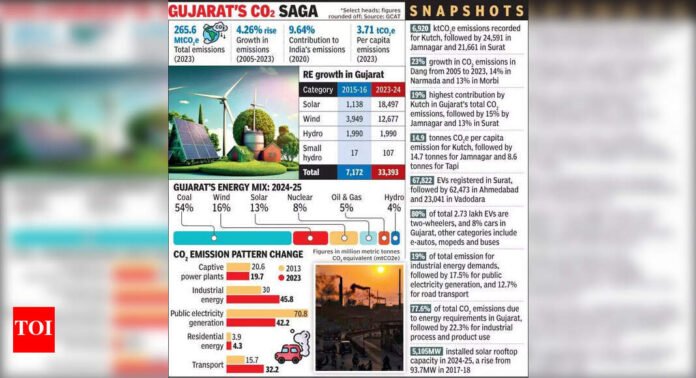How Gujarat Cut CO2 Emissions: A Renewable Energy Win

Gujarat’s Journey to Lower Emissions
Ahmedabad: Gujarat is making great strides in reducing carbon emissions. The Gujarat Climate Action Tracker (GCAT) reveals that the state’s overall emissions in 2023 were slightly lower than in 2014. This marks the third year of steady or declining emission trends.
What the Data Shows
- Emissions from captive power plants dropped from 21.19 mtCO2e in 2014 to 19.71 mtCO2e in 2023.
- Public electricity generation saw an even bigger drop, from 78.35 mtCO2e to 42.17 mtCO2e.
- Renewable energy growth has offset these reductions.
The Rise of Renewable Energy
Gujarat has seen a huge boost in renewable energy capacity. It grew from 7,172MW in 2015-16 to 33,393MW in 2023-24. Solar energy is leading this growth. Experts believe there’s even more potential for renewable energy.
Emissions Trends Across Districts
Out of Gujarat’s 33 districts, nine have shown a decrease in CO2 emissions since 2014. The biggest reductions were in:
- Amreli: 4.8% decrease
- Junagadh: 4.2% decrease
- Sabarkantha: 3.5% decrease
- Kutch and Chhota Udepur: 3.4% decrease each
However, 24 districts saw an increase in emissions, ranging from 0.3% in Surat to 23.7% in Dang. Experts link this to land use changes in less-industrialized districts.
Actions Making a Difference
A state official pointed out several district-level initiatives:
- Turning waste into energy
- Plans to tackle climate change and protect the environment
- Encouraging the use of electric vehicles
- Trading mechanisms for particulate matter (PM) emissions
- Planning and implementing climate strategies
- Issuing green bonds
“Tackling climate change requires a multi-faceted approach. This includes cutting emissions and promoting good practices,” the official stated.



